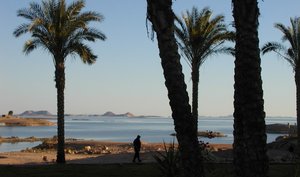Lake Nasser
|
|

Lake_Nasser_location.png
Lake Nasser (Arabic: Buhayrat Nasir) is a vast artificial lake in southern Egypt and northern Sudan. Strictly, "Lake Nasser" refers only to the much larger portion of the lake that is in Egyptian territory (83% of the total), with the Sudanese preferring to call their smaller body of water Lake Nubia.
It was created as a result of the construction of the Aswan High Dam across the waters of the Nile between 1958 and 1970.
The lake is some 550 km long and 35 km across at its widest point, which is near the Tropic of Cancer. It covers a total surface area of 5,250 km� and has a storage capacity of some 157 km� of water.
The rising waters of the dam required major relocation projects that were carried out during the 1960s.
Several important Nubian archaeological sites were dismantled block by block and moved to higher ground, most notably Abu Simbel. The Sudanese river-port and railway terminal of Wadi Halfa was lost beneath the waters and a new town was built in its place; and Egypt's entire Nubian community from the upper reaches of the Nile – numbering several hundred thousand people – saw their villages disappear and were forced to relocate.
The Egyptian name is in honor of President Gamal Abdel Nasser, who was the mastermind behind the controversial High Dam project.
Rising lake levels through the 1990's resulted in spilling over of waters into the Western Desert, forming the Toshka Lakes beginning in 1998.
